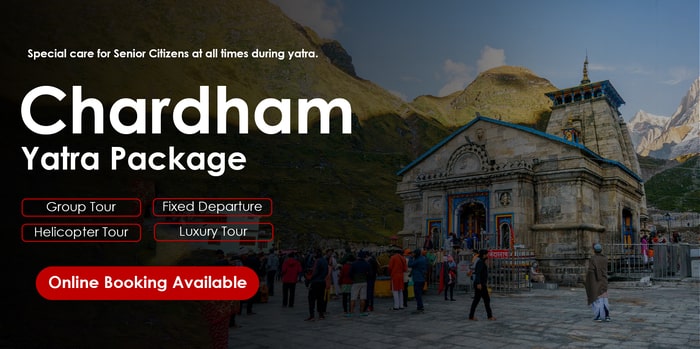Last Updated on March 3, 2025
Every state in India is known for its uniqueness in traditions and beliefs, and the same is true for the hill state of Uttarakhand. Folk dancing can trace its ancestry to ancient times and has developed over the years. Traditional dance here is known for being unique, colorful, vibrant, and is a very common occurrence. People dance to celebrate everything, from holy occasions and festivals to special days of the year and weddings, among other important events. They do this while wearing traditional attire that is quirky and colorful in its own way, and it is notable for being extremely pleasant and appealing to people from the plains.
Uttarakhand folk dances are not complex or difficult to learn and perform. This art form is performed in incredibly rhythmic synchronization and is a stunning sight to witness. Men and women come together to perform various dances to please the gods and goddesses as a way of paying homage. They believe that if these dances are not performed properly, the gods will be displeased.

Uttarakhand folk dances are not complex or difficult to learn and perform yourself. This art form is performed in incredibly rhythmic synchronization and is a stunning sight to witness. Men and women get together to perform various dances and please the gods and goddess as a way of paying homage since they believe that if these dances are not performed properly then the gods would be prejudiced.
History of Dances of Uttarakhand
The ancient beliefs and traditions of the ethnic tribes and people are deeply rooted in their dance forms, representing their culture through this medium. The art of dancing here owes its inspiration to the enchanting mythological young dancing women who have made the snowy mountains their home, depicted as Paries.
But who are these Paries? Some people say that these dancing girls are the souls of young unmarried women who died without proper cremation rituals. They were also believed to be the daughters of the evil king Ravan, who handed them over to Lord Shiva as handmaidens. Another tradition regards them as part of the legend and traditions of Krishna, depicting them as Gopis or “celestial dancers” in Krishna’s court.
No matter what the history says, the dances here possess their own charm and beauty, which can only be experienced by witnessing them firsthand.
Types of Folk Dances of Uttarakhand:
1- Langvir Nritya
- Popular Region: Performed mainly in the Tehri Garhwal region.
- Acrobatic Feats: Dancers balance themselves on top of a bamboo pole.
- Instruments Used: Folk music played with Dhol and Damau.
- Historical Significance: One of the oldest and most famous dance forms in Uttarakhand.
This is one of the most popular dance forms here and is mainly performed in the Tehri Garhwal region. The dance is primarily performed by the men of Uttarakhand and is done in an acrobatic form using a bamboo pole fixed in one place. The dancers climb up the pole and then balance themselves with the help of their stomachs on top. Under the pole, various bands of musicians perform folk and traditional music and songs with the help of the Dhol and Damau. Apart from the balancing act, the person on top also rotates skillfully while performing various acrobatic feats using their hands and feet. It is one of the oldest and most famous dance forms in Devbhoomi Uttarakhand.
2- Ramola
- Origin: Originates in the Kumaon region.
- Seasonal Dance: Celebrates the arrival of spring and the Holi festival.
- Community Dance: Performed by the Bard community who travel and announce spring.
- Cultural Importance: Marks the most important time for agriculturalists.
This charming and traditional dance of Uttarakhand is a well-preserved heritage of the Bard community, who roam from one place to another while simultaneously performing their traditional dance with the Dhol, Harmonium, tabla, etc., to welcome the spring season. This cultural folk dance, performed with great joy and happiness, holds significant mythological importance. Originating in the Kumaon region of the state, this dance marks the Holi season, which is later celebrated for a whole month. In the past, this dance was also performed by wandering minstrels who went from village to village to announce the arrival of spring, which is considered the most important time of the year for agriculturalists.
3- Bhotiya Tribal Dance
- Performed By: The Bhotiya tribes of Uttarakhand.
- Ritual Connection: Associated with death ceremonies and the liberation of souls.
- Similarities: Similar to dance forms in Himachal Pradesh and Nagaland.
- Traditional Dances: Includes ‘Dhurang’ and ‘Dhuring’.
As the name suggests, this ritual is performed by the Bhotiya tribes of Uttarakhand, one of the ancient tribes of the state. They have managed to preserve their rituals and traditions over the years, which is an achievement in itself. The performance of this dance is connected to death-related ceremonies. According to their traditions, the departed soul of the deceased individual makes the body of a goat or sheep their home, and by performing this dance, their souls are believed to be liberated. The typical dances of the Bhotiya tribe include ‘Dhurang’ and ‘Dhuring’. This Bhotiya dance is quite similar to the dance styles in Himachal Pradesh or even the hunting dances performed in Nagaland.
4- Chhapeli
- Courtship Dance: Performed by men and women, symbolizing the bond between two people.
- Symbolism: The male performs as a lover, and the female as the beloved.
- Dance Style: Simple swaying motion with colorful handkerchiefs and mirrors.
- Musical Instruments: Manjira or flute is used to create the rhythm.
This is one of the most colorful and fun-filled courtship dances, performed by both men and women of Uttarakhand. The concept of this dance does not require the performers to be actual lovers. The main aim of the dance is to enhance the bond between two people. The dance takes place in a simple swaying motion and is not complex. The male performers act as the lover, while the female takes on the role of the beloved. She also holds a colorful handkerchief in her right hand and a mirror in her left hand. The dance is quite mesmerizing, and the music is brisk, bright, and peaceful, played with the help of a Manjira or a flute.
5- Pandav Nritya
- Mahabharat Tribute: Depicts the birth and death of the Pandava kings.
- Performed During: Diwali and Dussehra celebrations.
- Community Participation: People dress up as characters from the Mahabharata.
- Cultural Significance: Keeps the local folklore alive.
Uttarakhand is also known as ‘the land of the Pandavas’ because they are believed to have come to the state in search of the stairway to heaven. This dance form is an ode to these famous Mahabharata heroes. Through various dance styles, the birth and death phases of the Pandava kings are depicted. Different incidents from the Mahabharata are showcased, with the performers dressing up as these different characters. It is somewhat like the Ram Lila, and just like that, it has managed to keep the local folklore alive among the people. It is primarily performed during the holy eve of Diwali and Dussehra, with a large group of dancers performing together in unison, making it a sight to behold.
6- Barada Nati
- Performed During: Religious and social occasions in the Jaunsar-Bawar region.
- Dance Style: Men and women dance together in colorful traditional costumes.
- Purpose: Marks the beginning of social gatherings or puja rituals.
- Symbolism: Represents free spirits and positivity in life.
Performed during religious occasions and other social functions, this dance form is the most popular in the Jaunsar-Bawar area of Chakrata tehsil in Dehradun. Both men and women take part in this dance, dressed in colorful and traditional costumes. This dance marks the beginning of any social gathering or puja ritual. The dance form represents free spirits and the purity of life, encouraging people to relax and look at the brighter side of life, especially during celebrations like marriages and births.
7- Jagar (Ritual)
- Spiritual Dance: Performed to honor gods, goddesses, spirits, and fairies.
- Accompanied By: Folk songs, drum beats, and music.
- Trance-like Experience: The performance creates a trance-like atmosphere.
- Sacrificial Rituals: Sometimes includes sacrifices like goats or birds.
This folk dance falls under spiritual and ghost worship and is accompanied by regional folk songs. A ritualistic dance is performed in the form of a puja, with folk songs sung to honor various gods, goddesses, spirits, and even fairies. This performance is done with music, singing, and the occasional beating of drums. The listener feels as though they have been transported into a trance by the incredible sounds. Spirits are also summoned, and they generally demand a goat or bird sacrifice. Along with dancing, performers may place their hands in blazing fire without being harmed and perform other incredible acts.
8- Chholiya
- Historical Roots: Dates back to 1000 years, associated with warring Kshatriyas of Kumaon.
- Purpose: To ward off negative spirits during weddings.
- Sword Dance: Dancers perform while holding swords, symbolizing battle.
- Occasions: Now performed in processions and other celebrations.
The roots of this traditional dance can be traced back almost 1000 years to the warring Kshatriyas of the Kumaon region, when marriages were celebrated with the clash of swords. It was also performed to ward off negative spirits believed to be following the baraat, as they were thought to target people’s happiness. Anyone performing the Chholiya dance during that time was believed to rid themselves of these negative energies. The performance, where dancers are dressed in colorful folk attire, takes place to the rhythmic beating of drums that sound like music depicting war-like situations. It is now performed in various other processions and occasions.
9- Jhumeila
- Folk Song: Primarily a folk song performed with traditional dance.
- Occasions: Celebrates various festivals like Guru Purnima, Baisakhi, and weddings.
- Symbolism: Expresses the sadness of newly married women missing their former life.
- Tribal Roots: Mostly practiced in remote regions.
While generally popular as a folk song, the Jhumeila is also accompanied by a traditional dance. This dance form is performed to mark major and minor occasions, fairs, and festivals such as Guru Purnima, Baisakhi, Makar Sankranti, wedding processions, or any other nature-related festival. Though it is primarily dedicated to women, men also participate in this dance. The steps and expressions represent the feeling of sadness experienced by newly married women who miss the happy moments they had cherished before their marriage. Being a tribal song and dance combination, it is only limited to remote regions and is not widely recognized elsewhere.
10- Thali – Jadda – Jhainta
- Performed By: Primarily women, later joined by men.
- Wedding Tradition: Takes place during wedding ceremonies.
- Balance Act: Dancers balance a metal plate on their head while spinning.
- Circle Dance: Performed in circles with singing and folk music.
Performed primarily by the women of Uttarakhand, this graceful dance takes place during wedding ceremonies and is later joined by men. As per the tradition, the dancer must balance a metal plate on their head while simultaneously spinning. It is mainly performed in the Kumaon region and involves men and women singing folk songs and playing folk music in circles. This dance is a symbol of happiness and joy, welcoming positivity into any occasion where it is performed.
11- Jhoda / Chachari (Chanchari)
- Synchronized Dance: Performed with linked arms, moving in a slow, synchronized circle.
- Community Dance: Both men and women participate.
- Names: Known by different names like Jhadawa, Jhora, and Jhawad.
- Cultural Importance: Performed during community gatherings and celebrations.
Jhoda and Chachari are a combination of song and dance performed together within the communities. Jhoda is sung while participants link arms and move in a slow but synchronized circle. Both males and females take part in this dance in different groups. It is also known by other names such as Jhadawa, Jhora, and Jhawad.




 Call
Call WhatsApp
WhatsApp Enquiry
Enquiry
Excellent coverage and a good write-up for Art & Culture lovers like me! Thank you.